Spill? What Spill?
Foundation Findings #40 - March 2005
Products to Keep Fuel Where it Belongs — In Your Tank
It’s hot, the harbor is crowded, and you have been circling the fuel dock for 25 minutes waiting your turn. Finally you snag a spot on the dock. You’re pumping diesel as quick as you can when your grandson tugs on your arm, begging for spare change for an ice cream sandwich from the ships store.
With your wallet hand deeply in the pocket of your Bermuda shorts, your tanks are suddenly and unpredictably full. Before you can say “Eskimo Pie,” pink diesel is tumbling out of your tank vent, down the side of your new gel-coated hull, and hitting the water—naturally, right as a mama duck leads a family of fuzzy ducklings by. In one careless moment, you’ve streaked your gelcoat, broken a federal environmental law, and insulted nature right in her face.
Has this ever happened to you or someone you know? You are not the only one.
The Issues
Fuel tanks on boats are not pressurized like they are in automobiles. Because of this, inboard boat tanks have an air vent to relieve the pressure that builds while filling a tank. (Learn more about why boats “burp.”) As a result, no matter what kind of boat you have and no matter how careful you are during fueling, it is really quite easy to spill fuel out into the water if you don’t take a few simple precautions.
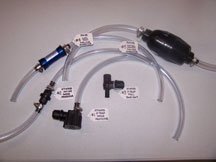
Couple that with the law. Under federal law, you are required to report a fuel or oil spill, no matter how small, if it is enough to cause a sheen on the surface of the water. And by creating a sheen, you are breaking a law and opening yourself up to fines that can go into five digits. While you want to get rid of the sheen, it’s also illegal to use a couple of squirts of dishwashing detergent on the water’s surface. Add this all up, and you can see how the nature of boat fuel tanks and the law don’t exactly make compatible bed fellows.
Whether it’s your concern over the environment, worry over landing a fine for pollution, or your quest to keep caustic chemicals off your teak and gelcoat, you’ve probably got a vested interest in keeping your fuel’s journey from nozzle to tank a clean and simple one. So how do you do that?
Couple that with the law. Under federal law, you are required to report a fuel or oil spill, no matter how small, if it is enough to cause a sheen on the surface of the water. And by creating a sheen, you are breaking a law and opening yourself up to fines that can go into five digits. While you want to get rid of the sheen, it’s also illegal to use a couple of squirts of dishwashing detergent on the water’s surface. Add this all up, and you can see how the nature of boat fuel tanks and the law don’t exactly make compatible bed fellows.
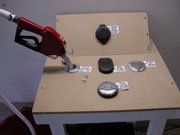
Plus, in the course of testing, we got familiar with different absorbent pads, catchment devices, fueling bibs and donuts, as well as other supplies that can come in handy while fueling any boat. Finally, there are some tried and true techniques for fueling that will reduce the chances of overfilling. The end result of all this research is that we found there’s an option for every single boater. We hope this information will help you find the right answer for you.
Testing Protocols
In this consumer product testing, conducted in October 2004, we evaluated readily available boat products including inline fuel/air separators, combination deck fill and vents, and fuel computers. With strict orders not to spill one single drop of fuel into the environment, we came up with two different methods of testing these products: first, a shore-side boat mock-up using a soapy water recipe as our fuel product and second, several friends’ boats, which allowed us to test the inline fuel/air separators and fuel computers on real vessels. Here’s how we did it.
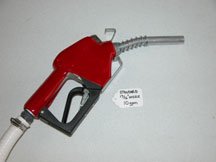
The Mock-up: To test these hardware options, we assembled a mock-up of a boat’s hull, deck fill, tank and tank vent according to American Boat and Yacht Council (ABYC) construction standards. We used certified United States Coast Guard (USCG) components including an 11.5 gallon fuel tank and approved hoses. Then we installed the various deck fills on the “deck” of our mock-up. Below decks, we had good access to easily change the various inline devices. We did not test any combination of devices. In other words, we did not use an inline separator and a combination deck fill and vent at the same time.
After our initial control tests, we substituted the black 5/8” USCG approved vent line with clear vinyl tubing in order to see the bubbly “fuel” venting as it occurred. (Please note that clear tubing is not approved by the Coast Guard for fuel.) Then, to put these products to the real test, we installed each inline fuel/air separator and each fuel computer on motor boats ranging in size from 21’ to 55’. Since the deck-mounted combination deck fill and vent units would have required drilling holes in our friends’ boats (and friends with boats are good friends to keep), those products were only tested on our mock-up.
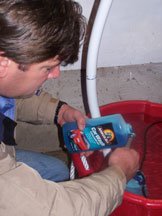
The Nozzles: To test our devices, we obtained fuel nozzles from a marina distributor and powered them with an electric pump. We used a standard ¾” nozzle that delivered 10 gallons per minute (g.p.m.) and a high speed 1 ¼” nozzle that delivered 20 g.p.m. to replicate the flows found at the fuel dock.
The “Fuel”: Using soapy water solutions, we formulated realistic substitutes for both gasoline and diesel. After evaluating a variety of soap products, we decided on using car wash soap, which bubbled up initially then settled down rapidly, just like fuel. After many test trials, we settled on adding ¼ teaspoon of car wash soap to 15 gallons of water for “gasoline.” For our “diesel” mixture, we added ½ teaspoon of car wash soap to 15 gallons of water because of diesel’s greater foaming characteristics. It was essential to get these mixes right, or we couldn’t expect the devices we were testing or the automatic shut-off for the fuel nozzles to work properly.
The Method:Some of the products tested were designed for gas, some for diesel and some for either. We only tested products with their intended fuel. To deliver the fuel, we stuck to the same method in test after test. We filled the tank at full speed until the nozzle clicked off. We did not top off. We felt that this method best represented the practices of the majority of boaters, and it allowed us to provide the same fuel delivery speed each time.
Inline Fuel/Air Separators
An inline fuel/air separator is a simple and inexpensive device that is installed directly into your tank’s overboard vent line. As the fuel tank gets full and frothy fuel surges up from the tank, a ball rises and cuts off the travel of fuel that would normally escape overboard via the vent. Some of these devices claim to help shut off automatic fuel nozzles when your tank is full. Although none of the devices tested had a special whistle integrated to indicate fuel level (a feature we really loved in a now discontinued product) there was still an audible difference in some of the units when the tank was near full.
Racor Fuel/Air Separator (Gas Or Diesel)
At first, we balked at the size of the LG100 (about the size of an oblong grapefruit). It was the largest of the units tested and we had just enough clearance to install it. But once installed, it worked each and every time on our mock-up and our loaner boat. When the tank became full, it allowed the automatic shut-off on the nozzle to disengage in plenty of time without venting fuel over the side or causing backsplash from the deck fill—with not one spill! We feel that because of its large size, it acted like a reservoir, allowing for additional room for fuel expansion. The larger size of this unit also provided the opportunity for fuel to settle before returning it to the tank and giving the nozzle time to click off. It works well with either gasoline or diesel and was the only product in our testing line up that could be taken apart if necessary. For these reasons, the Racor LG100 was the STAFF PICK for Foundation Findings #40. Model #LG100 retails for $109.99, and it can be ordered through West Marine stores, internet and catalog sales.
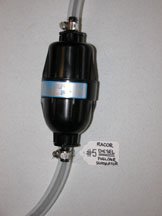
Attwood Fuel Vent Line Surge Protector
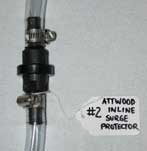
This was the smallest of the inline devices we tested, about the size of a roll of quarters. This device is a gasoline-only model (no diesel model is available), but we were told by the manufacturer it is compatible with diesel as well. However, when we tested it with the soapy “gasoline” mixture at 10 gpm, this device did not allow the nozzle to click off in time and fuel bubbled from the deck fill and overflowed onto the deck. When we tested this device at 20 gpm, it “overpowered” the unit causing some minor spillage through the overboard vent, and a significant amount of backsplash from the deck fill. In fact, during our onboard boat test later, we witnessed a column of fuel about three inches in height and two inches in diameter shoot up from the deck fill when the tank became full. In both testing situations, the device made some gurgling noises to indicate a rise in fuel, so a prudent mariner should heed this audible cue and slow down. Model #1675 retails for $23.99, and it can be ordered through West Marine stores, internet and catalog sales.
Attwood P-Trap Fuel Surge Protector
This unit looks different because it combines a fuel separator, fuel vent and flame arrestor in one unit and is roughly the size and shape of a fist. The Attwood P-Trap is installed on the inside of your hull with the vent portion replacing your existing overboard vent on the outside of your hull. Since this unit is plastic, we were concerned about the possibility of crushing it on a piling in a docking maneuver. To test, we again delivered fuel at 10 gpm and 20 gpm and the results were that as the unit suddenly prevented fuel from escaping overboard, backsplash from the deck fill occurred. With high speed fuel delivery, the pressure even slightly “overpowered” the unit, causing a simultaneous leakage of fuel overboard from the vent and fuel overflow on deck. Model #1689 retails for $21.54, and it can be ordered through West Marine stores, internet and catalog sales.
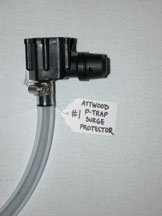
Inline Fuel/Air Separator Summary
We discovered a very disturbing trend with most of the inline devices tested. For most of the units, pumping at 10 gpm until the automatic shut-off nozzle clicked off caused fuel to bubble over the mock-up’s deck. The results were even more disastrous when we pumped at 20 gpm. Due to the sudden blockage of the vent by the rising ball in the inline separators, fuel (mixed with air), was then forced out of the actual filler hole!
We did not slow down our pumping, even when we heard gurgling, which may account for some of the less than positive results. But since many people lock the pump handle and walk away, we felt that filling at full speed simulated a realistic situation. For these reasons we do not recommend using a hands-free device and we do recommend keeping your hands and face clear from the filler hole.
In general, the larger the unit and the slower you pumped, the better these devices performed. The fact is, there is simply is no substitute for careful and deliberate fueling. Listen to these devices, know how much fuel you need and slow down when you think you are near full. Do not top off and these devices may suit you just fine.
Vented Deck Fills
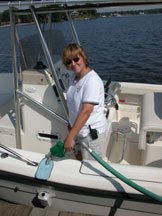
Combination deck fills and vents, or vented deck fills, literally combine the fuel vent (that usually vents overboard) with the deck fill. Essentially, the vent line is redirected into the neck of the fill allowing vented fuel to return safely to the tank. When these units are installed at the factory, there is no need for an overboard vent. However, if you choose to install one of these devices yourself you must seal off your existing overboard vent so that water does not condense or siphon into your boat.
You may also have to cut a slightly larger deck opening to accommodate this larger fixture. This new unit allows for movement of air into and out of the tank via the cap and essentially functions as a vent when not refueling. For this reason, vented deck fills are not air tight, and therefore are NOT watertight.
Both Perko specifically bring this trait to your attention and urge you not to install this device in a location that can become substantially flooded or submerged. The Seacurefill device uses your existing vent and functions somewhat differently so water intrusion is not a problem with this unit.
Attwood Angled Vent Deck Fill
The Attwood Angled Vented Deck Fill features a hinged plastic cap and a stainless filler An Attwood bran angled combo fill/vent wth flip topneck with an integral vent and splash guard to prevent spills. The angled neck of this model allows for various installation orientations, including an An Attwood brand angled deck fill in the open positionangled surface. We chose to mount it on a 45 degree angle which allowed for good visibility to see the internal vent (which is inside the filler neck) when refueling. This gave us the comfort of looking around the inserted nozzle for hints that the tank was nearing capacity.
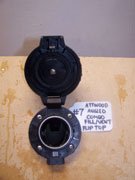
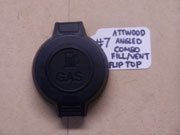
During our mock-up test, with the nozzle fully inserted and pumping at both 10 gpm and 20 gpm, fuel managed to back up the filler pipe and trigger the auto shut-off on the pump nozzle too late. At 10 gpm, the splash guard managed to redirect most of the fuel back into the tank, but at 20 gpm, fuel worked its way past the guard and ended up on our deck. Since the unit was mounted on a 45 degree angle, the vent was actually slightly higher than the fill opening and we wondered if this characteristic contributed to the auto nozzle clicking off too late.
On the plus side, its built-in plastic splash guard minimized “misting,” which occurred on other models when vented fuel bounced off the nozzle, keeping the deck essentially dry until the tank became full. This unit requires a grounding wire to prevent sparking when a nozzle is inserted, so please refer to the instructions for safe installation. Model #3682 retails for $59.99 and can be ordered through the BoatU.S. and West Marine catalog sales special orders department.
Perko Combination Fill & Vent Flip Top
Perko offers many styles of vented fills for gas, diesel and water. The model we tested was a black A deck fuel fill on display in the open position.plastic deck fill with a hinged “flip top” opening that did not require a deck key and was clearly labeled “gas.” Because it was hinged, the lid could not roll into the water but we did worry that when open, someone stepping on it could break it. Since this model is all plastic, no special ground wire was required.
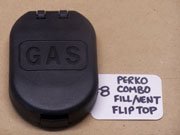
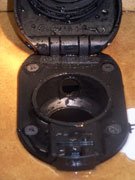
Because of its hinged design, there was no beaded retainer chain for the lid getting in the way of visibility into the neck of the deck fill. When the fuel tank was nearly full, we could easily see that the vent was doing its job by redirecting vented fuel back down the filler neck during the refueling process. As in other tests, we waited for the auto shut-off device to disengage. Unfortunately at both 10 gpm and 20 gpm testing, fuel spilled out of the filler neck suddenly just as the nozzle clicked off and flowed onto the deck. We also found that the larger nozzle (delivering 20 gpm) did not fit very well in the deck opening and we experienced slight misting on the deck during the fueling process as a result of the vented spray hitting the nozzle and landing on the deck.
This unit and other Perko models can be ordered through the BoatU.S. and West Marine catalog sales special orders department.
Perko Combination Fill & Vent Set
This Perko product featured a round polished chrome cap and a plastic body. The cap has a beaded stainless steel retainer chain which is attached to the inside of the neck, making a snug fit for the nozzles. The tight fit blocked our view of the vent, so we couldn’t observe the venting process as it occurred. Additionally, the tight fit caused misting on the deck as we noted with other units, especially at the higher velocity. A ground wire is NOT recommended on this unit because of its plastic body and the possibility of an electrostatic discharge.
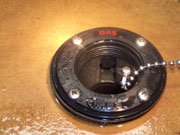
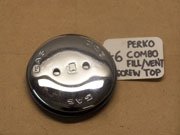
Note: The United States Coast Guard and the American Boat & Yacht Council (ABYC) are concerned enough about the possibility of sparking that as of 2/10/05 they have issued a Coast Guard Warning & Technical Bulletin for safe installation.
During testing, we experienced results similar to the other models previously tested. At 10 gpm, the tank would suddenly become full and backsplash would spill out of the deck fill just as the automatic shut-off nozzle disengaged. And at 20 gpm, even more fuel flowed from the deck fill and onto our deck. Model #0541 retails for $28.99 and can be ordered through the West Marine catalog sales special orders department.
Seacurefill Fuel Recovery System
The Seacurefill is a different kind of vented deck fill. Instead of having an integrated vent, it requires you to permanently install a new vent fitting in the deck adjacent to your existing deck fill. It works by redirecting the vented fuel back into the original deck fill via a piece of clear vinyl tubing that you must attach temporarily each time you fill up your boat. The concept is simple - the clear tubing literally allows you to see the venting process during refueling so you will react and slow down in response to the rising fuel bubbles.
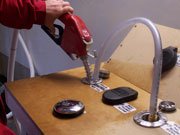
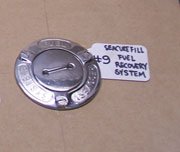
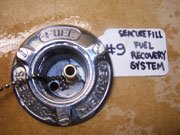
To install, you must cut a hole in your deck about the same size as your existing deck fill. You do not have to abandon your existing vent, but below deck, you will need to fit your existing 5/8” vent tube to a nipple on the bottom of the unit and add another short section from the Seacurefill unit to the existing overboard vent. This allows for the boat’s vent system to breathe and operate normally when not refueling.
We tested this device as we did the other units – at both 10 gpm and 20 gpm and pumped until the handle clicked off. In a way, this was an unfair disadvantage since this unit relies on you “seeing” the venting process so you can react by slowing down. Regardless, we carried out the test as planned using the standard “control fill” and found that that this unit allowed the nozzle to click off just in time (we could see fuel rising in both the clear tube and fill level) with minimal spilling at 10 gpm.
STAFF PICK: For cost, convenience, and reliability, our staff chose the Racor Fuel/Air Separator as the best venting product tested. Whether its a small tank on a sailboat or a large tank on a powerboat, we think it would work well They retail for a little over, $100.
For the 20 gpm delivery, we saw fuel enter the tube but fuel rose too rapidly for the automatic shut-off nozzle to disengage, spilling out a few ounces onto the deck. Seacurefill does make a 2” model that we suspect would better accommodate larger nozzles and higher delivery speeds. The 1 ½” Model retails for $139.00, and can be purchased at BoatU.S. and West Marine stores and through internet and catalog sales.
Vented Deck Fill Summary
The vented deck fill is a good concept, but we only recommend these products if you use them with caution. The vented deck fills did not promoteA failed test of the fuel fill system shows soapy water (representing fuel) splashing out of the fuel fill. backsplash as much as some of the inline separators did, but we were surprised by the fuel that found its way onto our decks. In general, these devices have a slight advantage over the inline separators: if you move the Another demonstration of a failed fuel fill-up.nozzle over to one side, you may be able to see when the unit begins to vent into itself and slow your speed of fuel delivery. The Seacurefill gives the most visible cues since clear tubing allows you to see precisely when your tank begins to vent, signaling your tanks are full.
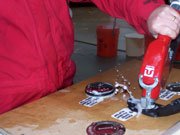
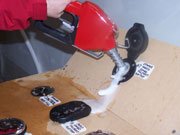
In general, we found that while refueling at 10 gpm, the amount of fuel from the venting process wasn’t significant enough to trip the auto shut-off fuel nozzles. Many times, the auto-stop feature disengaged just as the fuel reached the top of the deck fill, so the spills were contained to only a few ounces. However, none of the devices tolerated the high-speed fuel delivery at 20 gpm and sometimes spilled as much as a cup or more from the deck fill. Fuel would often continue to gurgle up and onto the deck, even after the nozzle clicked off. Additionally, because these deck fills have integrated vents, the nozzle opening was snug which made them prone to misting the deck with fine droplets of fuel.
As with the inline separators, we’ve learned you should never rely on the auto-stop nozzle triggering off in time. You will want to use an absorbent fuel collar, bib or pad to catch droplets, but do keep in mind this will restrict your ability to see what’s happening in and around the vent area. Also, always fuel slowly as you reach the top of your tanks.
Fuel Management Systems
Testing the fuel computers reminded us of how expensive “fueling” our hobby can be, but they were a real eye-opener as we learned all sorts of tricks to make our boat go further on a single tank of gas. They can really be construed as the “must-have” gauge for your boat. They are rather simple devices that do not rely on sophisticated moving parts. They not only help track on board fuel usage and how much you need at the fuel dock, but also help reduce fuel consumption and increase your range.

Furthermore, a fuel computer can actually serve as a diagnostic tool. For instance, a decrease in GPH could indicate a problem in one of the engines such as a blocked fuel line, spotty injectors or fouled fuel filter. An increase in GPH could indicate other health issues such as improper firing, bad ignition timing or even a broken fuel line. An increase in both engines could mean a fouled bottom, improperly aligned shafts or nicked propellers.
For determining fuel level, we urge users not rely solely on the fuel computer alone. A prudent mariner will check and compare data with an in-dash gauge or a sight glass if available and will have absorbent pads ready when refueling. An experienced boater will also take into account other information including the feel of the helm, the wake and other cues to help determine peak efficiency and overall performance. A final note on fuel gauges. Resist the urge to check your in-dash fuel gauge while refueling your boat. It is a dangerous habit to have any electricity and charge flowing through your boat while dispensing fuel.
Some Solutions
This Foundation Findings allowed us to delve into a wide array of products, information, and techniques to help prevent small fuel spills and to better manage our fuel. It also reacquainted us with products that we can use on the fuel dock to help stop those drops and drips.

While testing inline fuel/air separators and vented deck fill fittings, our testing revealed that the Racor Lifeguard Inline Fuel/Air Separator (Model LG100) was the most dependable all around performer. We could rely on it to keep fuel from overflowing through the vent line and to keep backsplash from occurring up the deck fill. Because of its dependability, it earned the STAFF PICK for this series of tests. This oblong grapefruit shaped device (about $100 retail) may not fit in every boat, but where it will, we think it’s a good investment to make refueling a more worry-free event.
Throughout the course of our testing, we confirmed that there appears to be no one single answer to better manage fuel for each and every boat. Some boaters who buy large amounts of fuel may want to consider a fuel computer, which can quickly pay for itself when the boater is able to establish the most efficient RPMs and trim. For other boaters, a vented deck fill may be an option to help reduce overboard spilling, particularly if they are willing and able to slowly fill the fuel tank.
For everyone filling a fuel tank, there are also simple oil absorbent cloths, fuel nozzle donuts or bibs, and catchment devices to attach externally on the vent. These products are as useful for the marina fuel dock operator as they are for the individual boat owner. Learn more in our Clean Fueling Products Directory by clicking here.
The bottom line: anyone with an engine in their boat can do something to keep fuel drops out of the water. Thanks for your help!
This project is part of our ongoing national clean fueling campaign: Help Stop the Drops. If you have ideas, questions or comments about this information, feel free to send us an email at safeboating@boatus.com.
More Information
Boats are not Pressurized Like Cars!
Cars utilize a pressurized system to deliver fuel directly to engine injectors. This is done under high pressure delivered by a pump within the fuel tank to assure peak performance and economy. This type of system also does not permit air or fuel to escape from the tank during operation and does not have a vent to relieve pressure. Cars also have a carbon canister to control vapor emissions.
According to the Boat Safety Act of 1971, pressurized systems are not permissible for boats. If they were, in the event of a failure anywhere in the system, a large amount of fuel would collect in the bilge creating a very explosive situation. In addition, boats pound more while underway and fuel gets jostled, causing additional expansion. The pressure created must be released – and on boats, it is released though the tank’s breathing vent. Shake a can of soda and open the top and you’ll know the explosive answer as to why boat fuel systems aren’t allowed to be designed like cars.
Why Do Boats Burp?
When refueling rapidly or overfilling your fuel tanks, boats vent air that is often mixed with fuel. During refueling, gas goes into the tank and displaces air. The air escapes out through your boat’s fuel tank vent. When the tank is nearly full and there is no more air to displace, frothy fuel begins to bubble out into the water or onto your decks.
Additional expansion of the fuel (and subsequent leaks out of your boat’s fuel vent) may occur when cool fuel is pumped from underground storage tanks into the boat on a hot day, or during the rise and fall of outside temperatures.
Top Tips for Refueling Your Boat
- Know how much fuel your boat holds and how much fuel you need.
- Turn off engine, electronics, and extinguish all open flames, such as stove or cigarettes.
- Close hatches, ports and doors.
- Put passengers ashore during fueling.
- Use someting to catch spills out of the vent.
- If you use a portable tank, remove it from the boat and fill it on the dock.
- Use an absorbent pad or donut around deck fill to catch spills.
- Maintain contact between nozzle and deck fill.
- Hold onto the nozzle when refueling - don't use the hands-free clip.
- Fuel slowly, and listen for a change in tone as the tank gets full.
- Resist topping off - fill tanks to 90% capacity.
- Have absorbent pads ready.
- Do not use detergents to disperse spill.
- After fueling, turn the blower on for 3-5 minutes.
- Sniff bilges, the blower exhaust, and engine compartment for gas fumes.
- Go Boating!
For these reasons, you should never top off your fuel tank and you should always leave 10% of tank capacity for expansion. Also try to refuel when you are headed out, not when you are putting the boat away. Trailer boaters should take the added precaution to fuel their boats on a level surface, or air pockets can form in the tank that can lead to the burping or back splash of fuel.
Grounding Essentials and a Special Warning
A Caution About Grounding Your Deck Fill: Please check with your installation instructions regarding grounding requirements Coast Guard Warning: Fuel Fill Technical Bulletin, or refer to a marina or boat yard that is versed in American Boat & Yacht Council (ABYC) construction standards.
Because fuel nozzles are metal and the flow of fuel through it generates static, a small but dangerous spark (called an Electrostatic Discharge or ESD) can occur when the nozzle is inserted into a metal filler neck. To prevent sparking, a ground wire must be attached from the metal deck fill unit to the boat’s bonding system. Also, it is important that the nozzle remain in contact with the metal deck fill at all times while refueling. Never wrap a nozzle in an absorbent pad or rag so that it prevents a good contact between the nozzle and metal body of the deck fill. When refueling portable fuel tanks, always place directly on the ground, never on a plastic truck bed-liner or a dock made of synthetic plastic wood. Good contact between a portable tank and a solid grounded object is essential.
Special Warning for Plastic Body and Metal Fuel Caps: Deck fill units that have a plastic body with metal components such as a metallic lid or metal retaining chain, are NOT to be grounded. Read the important Safely Message & Technical Bulletin issued by the United States Coast Guard (USCG) in February 2005:
Recent events have caused the boating industry to examine the policy regarding the bonding of plastic body fuel fills with metallic caps and retaining chains. Existing USCG & ABYC policy states that the bonding of these components is voluntary. A study by IMANNA Laboratories has shown that connecting the metallic retaining chain and cap of a plastic body fuel fill assembly to a boats bonding system may result in electrostatic discharge from a land-based fuel pump nozzle to the metallic components of the assembly when the boat is not in the water. This condition does not exist when the boat is in the water due to the equalizations of the ground potentials between the fuel pump nozzle and the boats bonding system. It is recommended by ABYC and the USCG that new and existing installations of this type of fuel fill assembly DO NOT INCLUDE any attachment to the boats bonding system. Existing connections should be removed from the point of connection to the boats bonding system to the fuel fill assembly. Removal of the metallic components of the assembly is not necessary; however, the U.S. Coast Guard and ABYC still require that METALLIC body fuel fills be bonded. For further information contact: John Adey, ABYC (410) 956-1050 ext. 29 jadey@abycinc.org Richard Blackman (202) 267-6810 rblackman@comdt.uscg.mil.
Why are Boat Fuel Tank Gauges Inaccurate?
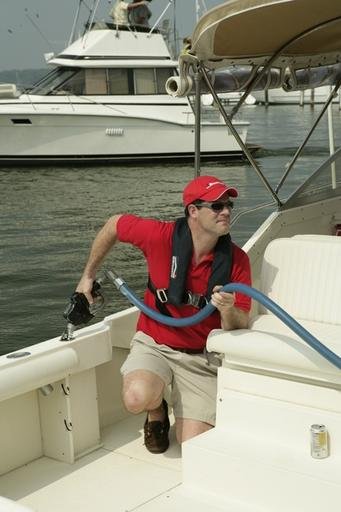
We wondered why so many boats have problems with fuel gauges so we asked around about why gauges seem to be inherently inaccurate. The A boater refuels his pleasure craft.response from manufacturers was “don’t blame the gauges!” Rather, the most common culprit cited was the sending unit (that’s why tapping on the glass rarely works)!
Most fuel gauges rely on a sending unit with a float that is often manufactured by a separate company. The float rises and falls with the fuel level and sends an electronic signal corresponding to a unit of measurement (usually ¼ tank increments) on your fuel gauge. Often, new boats are shipped on trucks when the fuel tanks are empty, causing the sender to bounce and become misaligned. Another potential reason for inaccurate readings is that tanks are often designed to fit the bottom contour of a boat and sometimes shaped like a triangle. This means that the sender and gauge must be compatible with unique tank shapes, and dropping in a stock sending unit is not likely to read accurately.
In addition to issues with the float arm and tank shape, there may be calibration, voltage fluctuation or grounding issues at play. The bounce, heel, trim and general abuse that a boat takes when operated affects proper readout as well. Have you ever come off a plane and suddenly have a different readout?
If your boat has some fuel gauge issues: 1) Manually inspect the sending unit in the fuel tank. Be certain it has no internal rubbing or an obstruction. 2) Check for proper voltage, wiring and ground connections and determine if the sender and gauge are compatible. 3) Visually calibrate by refilling your tank in known increments and make a few hash marks with an indelible marker right on your in-dash gauge at these intervals. This process will take some time, because you must return the nozzle to the pump and properly ventilate your boat (at least 4 minutes) each time before turning on the key to check the gauge to avoid a potential explosion.
If you have questions, comments or would like to share some personal experiences or observations, please contact us.

